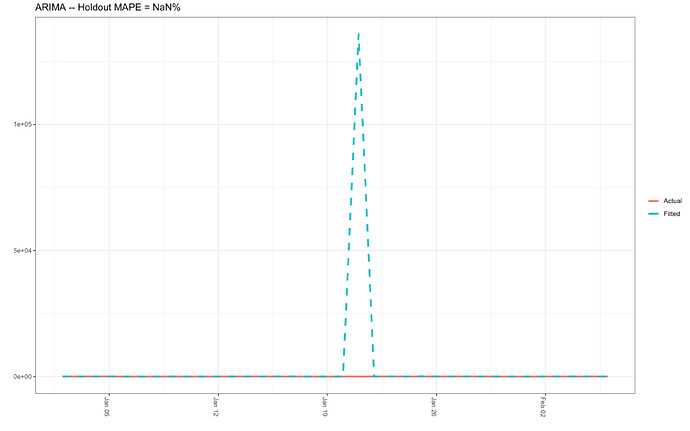Overview
I am conducting a time series analysis using an ARIMA model, and I would like to visualise the Mean Absolute Percentage Error (MAPE) in a plot (see below)
I am currently following this tutorial:
Issues
-
I have successfully run the R-code; however, the value produced by the object MAPE (see R-code below) is not a number, showing an Arima Holdout MAPE value of NaN %, which is definitely incorrect:
MAPE 1 NaN -
The numerical range of the y-axis on the ARIMA MAPE plot (see below) is spurious, ranging from zero to 10,0000 i.e., 0e+00 to 1e+5 (which is obviously incorrect), and, the date range on the x-axis is wrong because the date range for my data is 2015-2017. As a consequence, I have inputted the date range of 2015-2017 into both ts() and window() functions. The existence of this spurious data range is also responsible for the strange spike exhibited by the fitted data in the ARIMA MAPE plot below.
-
Moreover, the column named 'Date' produced by the object d4 (see R-code below) exhibits the year 1970 (see below), which does not make sense considering this is not the date range I inputted into my models:-
#These values are produced by the object d4 Fitted Actual Date 1 3.592659e+01 36 1970-01-02 2 2.798055e+01 28 1970-01-03 3 3.897144e+01 39 1970-01-04 4 4.596831e+01 46 1970-01-05 5 5.008207e+00 5 1970-01-06 6 1.009074e-03 0 1970-01-07 7 1.007765e-03 0 1970-01-08 8 2.194326e+01 22 1970-01-09 9 9.985120e+00 10 1970-01-10 10 1.497379e+01 15 1970-01-11 11 7.992608e+00 8 1970-01-12 12 3.292665e+01 33 1970-01-13 13 3.320180e+01 33 1970-01-14 14 2.568558e+01 29 1970-01-15
The dates on the x-axis should follow the same format as the column called 'Year (below)', which is produced when you run the BSTS_new_df object.
Year Month Frequency
1 2015-01-01 January 36
2 2015-02-01 February 28
3 2015-03-01 March 39
4 2015-04-01 April 46
5 2015-05-01 May 5
If anyone can please help me solve these issues, I would like to express my deepest appreciation.
Many thanks in advance.
R-code
#Set seed
seed(45L)
##Open packages for the time series analysis
library(lubridate)
library(bsts)
library(dplyr)
library(ggplot2)
library(ggfortify)
##Change the Year column into YY/MM/DD format for the first of every month per year
BSTS_df$Year <- lubridate::ymd(paste0(BSTS_df$Year, BSTS_df$Month,"-01"))
##Order the Year column in YY/MM/DD format into the correct sequence: Jan-Dec
allDates <- seq.Date(
min(BSTS_df$Year),
max(BSTS_df$Year),
"month")
##Produce and arrange the new data frame ordered by the first of evey month in YY/MM/DD format
BSTS_new_df <- BSTS_df %>%
right_join(data.frame(Year = allDates), by = c("Year")) %>%
dplyr::arrange(Year) %>%
tidyr::fill(Frequency, .direction = "down")
##Create a time series object
myts_Arima <- ts(BSTS_new_df$Frequency, start=c(2015, 1), end=c(2017, 12), frequency=12)
##Upload the data into the windows() function
Arima_Window <- window(myts_Arima, start=c(2015, 01), end=c(2017, 12))
### Fit the ARIMA model
arima <- arima(log10(x+.001),
order=c(0, 1, 1),
seasonal=list(order=c(0,1,1), period=12))
### Actual versus predicted
d4 <- data.frame(c(10^as.numeric(fitted(arima)), # fitted and predicted
10^as.numeric(predict(arima, n.ahead = 12)$pred)),
as.numeric(BSTS_df$Frequency), #actual values
as.Date(time(BSTS_df$Year)))
##Name the columns
names(d4) <- c("Fitted", "Actual", "Date")
### MAPE (mean absolute percentage error)
MAPE <- dplyr::filter(d4, lubridate::year(Date)>2017) %>%
dplyr::summarise(MAPE=mean(abs(Actual-Fitted)/Actual))
##Open a plotting window
dev.new()
### Plot actual versus predicted
ggplot(data=d4, aes(x=Date)) +
geom_line(aes(y=Actual, colour = "Actual"), size=1.2) +
geom_line(aes(y=Fitted, colour = "Fitted"), size=1.2, linetype=2) +
theme_bw() + theme(legend.title = element_blank()) +
ylab("") + xlab("")
geom_vline(xintercept=as.numeric(as.Date("2015-12-01")), linetype=2) +
ggtitle(paste0("ARIMA -- Holdout MAPE = ", round(100*MAPE,2), "%")) +
theme(axis.text.x=element_text(angle = -90, hjust = 0))
ARIMA MAPE Plot
Data frame - BSTS_df
structure(list(Year = c(2015, 2015, 2015, 2015, 2015, 2015, 2015,
2015, 2015, 2015, 2015, 2015, 2016, 2016, 2016, 2016, 2016, 2016,
2016, 2016, 2016, 2016, 2016, 2016, 2017, 2017, 2017, 2017, 2017,
2017, 2017, 2017, 2017, 2017, 2017, 2017), Month = structure(c(5L,
4L, 8L, 1L, 9L, 7L, 6L, 2L, 12L, 11L, 10L, 3L, 5L, 4L, 8L, 1L,
9L, 7L, 6L, 2L, 12L, 11L, 10L, 3L, 5L, 4L, 8L, 1L, 9L, 7L, 6L,
2L, 12L, 11L, 10L, 3L), .Label = c("April", "August", "December",
"February", "January", "July", "June", "March", "May", "November",
"October", "September"), class = "factor"), Frequency = c(36,
28, 39, 46, 5, 0, 0, 22, 10, 15, 8, 33, 33, 29, 31, 23, 8, 9,
7, 40, 41, 41, 30, 30, 44, 37, 41, 42, 20, 0, 7, 27, 35, 27,
43, 38)), row.names = c(NA, -36L), class = "data.frame")
